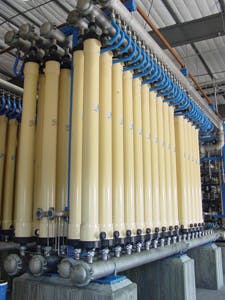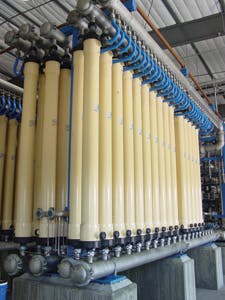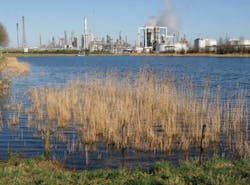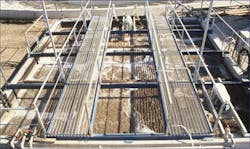By Jeff Gunderson, Industrial WaterWorld Correspondent
A wide variety of products are made in the chemical and pharmaceutical manufacturing industries, typically requiring large volumes of chemicals, materials, and substances that are used throughout process operations. Waste streams generated in these industries can be heavily laden with contaminants, toxins, nutrients, and organic content, presenting unique challenges in terms of treatment, especially as regulations become more stringent.
Additionally, as is the case in other industrial manufacturing sectors, water is a critical ingredient in pharmaceutical and chemical manufacturing operations; consistent and high-quality supplies are needed for a range of purposes including production, material processing, and cooling. As disruptions in raw water supply represent a significant concern, more companies are turning to water efficiency initiatives to help mitigate water scarcity-related risks.
Photo Credit: Pall
Another issue most notably in the pharmaceutical industry relates to contaminants of emerging concern (CECs) including pharmaceuticals and personal care products (PPCPs). These compounds are increasingly being detected in surface waters, driven largely by advances in analytical detection technologies, enabling constituents to be measured down to levels that were previously thought not possible. The EPA, which prepared a white paper detailing technical issues and recommendations in regards to the development of CEC criteria, has stated that CEC compounds may have an impact on aquatic life.
Water Efficiency
Rising concerns associated with water scarcity are becoming more of a significant issue across a greater number of regions, and especially in areas susceptible to drought and water shortages. Diminishing water supply is particularly disruptive to industries that are reliant on high quality process water for use in manufacturing. In order to mitigate potential water shortage risks and gain greater water security, industrial companies are increasingly implementing strategies that facilitate higher water efficiency.
Dr. Ram Venkatadri, global marketing manager for industrial water in the Energy Group of Pall Corp., said more plants in the chemical manufacturing industry are finding ways to recycle water from waste streams for reuse in plant processes.
"Raw water limitations present a very serious business risk, and many facilities are located in arid regions that are prone to disruptions in water supply," Venkatadri said. "Water recycling is becoming a huge trend in this industry and others because it presents a way for plants to mitigate water shortage risks and become less dependent on raw water supplies."
One notable target area for reuse in chemical manufacturing, as well as in power plants and refining operations, includes cooling tower blow down water.
"Previously, blow down water was discharged to the drain, but now facilities are treating that water and recycling it back for use as boiler feed water or in other processes," Venkatadri said. "Since blow down water tends to be very dirty, it requires higher levels of purification technology. However, the cost associated with implementing advanced treatments for the purpose of water recycling is actually becoming more economical as compared to purchasing influent water."
Cooling tower feed water is also being treated with advanced technologies to improve the performance of the cooling tower and to minimize wastage by blowdown, Venkatadri added.
Photo Credit: Dow
Extending the water reuse concept further, another important trend in the chemical industry, and also the power industry, is the increasing adoption of zero liquid discharge (ZLD), a practice that is beginning to drive many projects, according to Venkatadri.
"Under the ZLD concept, not a drop of water is allowed to leave the plant," he said. "Plants are utilizing innovative technologies such as membrane filtration and thermal evaporation/crystallization to treat, recycle, and reuse every drop of wastewater. In particular, ZLD is being incorporated in dry western states such as California, Arizona, Nevada, as well as overseas in Australia and India."
But as prevalent as direct water reuse is becoming in the chemical industry, this practice remains fairly restricted in the pharmaceutical industry due to contamination risks to the consumer, said Eric Meliton, an environmental technologies industry analyst with Frost & Sullivan.
"Although recycling from non-manufacturing point sources for reuse in irrigation or boiler system cooling water is commonplace in many pharmaceutical manufacturing facilities, treating waste streams for reuse as feed water in the product manufacturing process is limited," he said.
Still, depending on the specific product manufactured, there can be exceptions to this general rule, Meliton continued, but "because in most cases pharmaceutical process feed water has to originate from virgin sources, it is important that plants are located in areas with sufficient and stable water supplies," he said.
Sustainable, Innovative Approaches
Consistent with industry trends toward water efficiency, a greater number of newer plants in both the chemical and pharmaceutical industries are adopting more holistic and sustainable treatment practices and designs, said Chris Sacksteder, associate product director, RO/NF with Dow Water & Process Solutions.
"In the past, water treatment was mainly focused on pretreatment requirements. While pretreatment remains a key area of importance, more companies are assuming higher responsibility in terms of treating their wastewater streams," Sacksteder said. "Instead of targeting only the front end of the plant, water treatment strategies have expanded to include the whole plant."
Photo Credit: Siemens
Particularly in the chemical industry, plants are also minimizing the water they draw from external sources, reducing the amount of wastewater they discharge, and reusing water as many times as possible within their fence lines, Sacksteder added.
Additionally, chemical companies expanding overseas are increasingly turning to innovative treatment solutions for meeting their influent water needs. "In other parts of the world, and especially in rapidly developing economies, access to quality, dependable water sources can be very limited," Sacksteder said. "As such, companies are developing the ability to treat wastewater from other sources and subsequently use that water in process applications."
As an example, at Dow's Benelux facility located in Terneuzen, The Netherlands, community wastewater that was previously discharged to a river is now treated and reused in plant manufacturing processes and then again in cooling towers. According to Dow, every liter of water is used three times instead of once, a process that reduces the energy use for water purification by 65 percent.
Chemical Industry Treatment Trains and Regulations
Chemical industry waste streams can be highly complex, unique, and because of broad differences in the materials, processes and source waters used in chemical manufacturing, the resulting wastewaters can exhibit a considerable amount of variation in terms of volume, quality, and composition.
"Since every case tends to be different, each project tends to have a unique chain of treatment solutions for wastewater discharge or reuse that is tailored to a specific situation and need," Venkatadri said. "Treatment strategies and technologies are based on the overriding regulations, the desired end quality of the water, and the origination of the influent water."
According to Venkatadri, stricter regulations are increasingly coming into play.
"Projects are becoming environmentally driven, in response to higher EPA standards in relation to the removal of specific contaminants such as mercury, arsenic, cobalt, and selenium," he said. "Some of the newer, specified concentration levels are extremely tough to reach. As such, plants are replacing their traditional systems with integrated treatment technologies including microfiltration and ultrafiltration followed by reverse osmosis and/or nanofiltration, UV disinfection, biological treatment, and ion exchange."
Pharmaceutical Industry Treatment Trends
Industrial manufacturing processes in the pharmaceutical industry produce wastewater that is generally characterized as high strength organic effluent - waste streams that can be challenging to manage with conventional wastewater treatment.
According to John Brittan, technical director for the pharmaceuticals and microelectronics markets with Siemens Water Technologies, the four main constituents in pharmaceutical plant waste streams that regulators are generally concerned with include oil and grease, pH, suspended solids, and biological oxygen demand / chemical oxygen demand levels. But in addition to these constituents, Brittan noted that some of the more progressive states and municipalities are beginning to focus on the mineral content in pharmaceutical plant effluents.
"This is something that is relatively new to the pharmaceutical industry and represents an area of potential change," Brittan said. "As is the case with many regulatory issues, California is leading the charge in this area."
Depending on the pharmaceutical product manufactured, inorganic effluent mineral concentrations can vary, and can also be affected by raw water influent sources.
"Facilities that have higher mineral waste stream concentrations are likely to encounter difficulties because of the costs associated with that type of regulation and the fact that treating for mineral concentration reductions can be difficult," Brittan said. "Since inorganic minerals cannot be destroyed, treatment strategies may need to revolve around volume minimization, which in turn can present new challenges due to higher resulting salt concentrations. For plants that have to meet a specific discharge requirement for mineral content, the final waste volumes either need to be disposed of in evaporation ponds or treated with evaporators and crystallizers which can be extremely expensive."
Contaminants of Emerging Concern
CECs and PPCPs started attracting attention following a U.S. Geological Survey reconnaissance study (Kolpin et al. 2002) which documented the prevalence of a wide range of CECs in U.S. streams.
According to a review paper published in the Interview Journal of Environmental Science and Technology covering treatment options for wastewater effluents from pharmaceutical companies, there is a growing body of research examining the presence of active pharmaceutical ingredients in industrial wastewater, the treatment of these wastewaters, and the removal rates.
The paper found that traditional wastewater treatment methods such as activated sludge are not sufficient for the complete removal of active pharmaceutical ingredients and other wastewater constituents. As a result, complementary treatment methods such as membrane filtration, reverse osmosis and activated carbon are often used in conjunction with traditional methods for treatment of industrial wastewater. Additionally, membrane bioreactor (MBR) technology, ozonation, and advanced oxidation processes have shown varying degrees of efficiency for the treatment of pharmaceutical wastewaters, according to the paper.
But despite the recognition that CECs are present in pharmaceutical plant effluents, regulations in regard to CEC treatment have not yet been introduced in the industry, said Frost & Sullivan's Meliton.
"Regulators are assessing and studying CECs, but we don't see anything coming down the pipeline in terms of new regulation," he said. "There are substantial fears and concerns in relation to CECs, but no real regulation driver as of yet such as documentation or studies confirming the health risks associated with these compounds. Currently, the only studies that have been accepted by the EPA are those that prove that CECs exist in the water supply."
At the same time, the primary link to CECs in the water system is attributed to consumer discharges into the municipal wastewater system, which allows pharmaceutical companies to distance themselves from the responsibility associated with treating those constituents, Meliton added.
Although no pressure has been applied on the pharmaceutical industry to meet any requirements in regard to CEC treatment, many pharmaceutical companies are taking voluntary steps to address and treat effluent discharges in relation to these constituents, Brittan said.
"This is something that is actively changing in the industry. Companies are implementing sustainability and corporate responsibility initiatives that can include the adoption of higher-level treatment technologies such as carbon adsorption, precipitation and advanced oxidation processes that facilitate the removal of CECs and other contaminants."
CEC removal is also becoming more prevalent in terms of source water treatment, Brittan added. "Reverse osmosis and activated carbon are the two main lines of defense in this area," he said.





